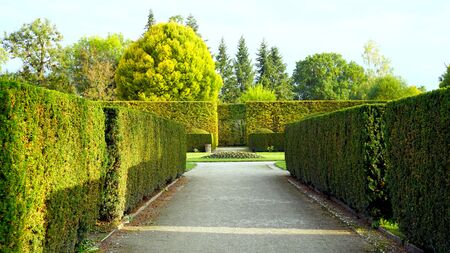Introduction: The Importance of Garden Pathways in British Landscaping
Throughout the history of British landscaping, garden pathways have played a central role in shaping not only the aesthetics but also the functionality and social atmosphere of outdoor spaces. From grand stately homes to quaint cottage gardens, pathways are far more than mere routes; they are integral features that guide visitors, structure views, and enhance accessibility. Their evolution reflects changing tastes, technological advancements, and shifting cultural values within the UK. By exploring the significance of these paths—from their origins in formal gardens to their adaptation in contemporary landscapes—we gain insight into how British garden design has consistently balanced tradition with innovation. This journey through time demonstrates how pathways have influenced not just the physical layout of gardens but also the way people interact with and experience these cherished green spaces.
Classic Pathways: Georgian and Victorian Influences
The evolution of British garden pathways is profoundly shaped by the Georgian and Victorian eras, both periods renowned for their distinct approaches to landscape design. These classic styles continue to inform contemporary garden aesthetics, especially in the context of historic estates and traditional properties across the United Kingdom.
Georgian Garden Paths: Order and Symmetry
During the Georgian period (1714–1830), garden pathways reflected the era’s fascination with symmetry, proportion, and clarity. Estate owners sought to emulate the grandeur of classical antiquity, resulting in paths that were straight, wide, and often flanked by manicured lawns or clipped hedges. The layout was typically formal, guiding visitors through carefully planned vistas.
Key Features of Georgian Pathways
| Feature | Description |
|---|---|
| Materials | Gravel, compacted earth, stone slabs |
| Layout | Straight lines, geometric patterns, axial alignments |
| Influence | Inspired by Palladian architecture and continental gardens |
Victorian Pathways: Ornamental Flourish and Industrial Innovation
The Victorian era (1837–1901) witnessed a dramatic shift in garden design philosophy. The Industrial Revolution introduced new materials and techniques, while a growing middle class spurred interest in ornamental gardening. Victorian pathways became more intricate and decorative, often curving gracefully through flowerbeds and around elaborate planting schemes.
Key Features of Victorian Pathways
| Feature | Description |
|---|---|
| Materials | Brick pavers, encaustic tiles, decorative edging stones |
| Layout | Sinuous curves, serpentine forms, integration with planting beds |
| Influence | Emphasis on display, colour contrast, and industrial craftsmanship |
The Influence of Estate Culture on Pathway Design
The British estate culture played a pivotal role in shaping both Georgian and Victorian pathways. During these eras, gardens were not only private retreats but also public statements of taste and status. Pathways functioned as ceremonial routes for promenading guests, emphasising a sense of arrival and guiding movement through significant landscape features such as orangeries, follies, or ornamental lakes.
By analysing these hallmark features—materials used, pathway layouts, and social influences—we gain insight into how classic British garden paths set a precedent for subsequent styles. Their legacy endures today in both heritage sites and modern reinterpretations throughout the UK.

3. Cottage Garden Charm: Informal and Meandering Routes
The cottage garden is a celebrated symbol of British horticultural tradition, renowned for its informal charm and romantic atmosphere. This quintessentially British style prioritises soft, winding pathways that guide visitors through a tapestry of colour and fragrance. Unlike the formal, straight-edged paths of earlier eras, cottage garden routes are purposefully meandering, encouraging leisurely exploration and spontaneous discovery.
Natural Materials and Organic Forms
Cottage garden pathways are typically constructed from natural materials such as gravel, reclaimed brick, or irregularly shaped flagstones. These choices reinforce an organic aesthetic and ensure the path blends seamlessly with its surroundings. The use of locally sourced stone or weathered timber not only grounds the design in its setting but also reflects a commitment to sustainability and authenticity—key values within traditional British gardening.
Boundary Planting for Enclosure and Interest
A defining characteristic of cottage gardens is the abundant planting that spills over the edges of pathways. Herbaceous perennials, old-fashioned roses, lavender, and self-seeding annuals create soft boundaries that blur the distinction between path and border. This approach fosters a sense of intimacy and enclosure while ensuring each turn in the path reveals new vistas and surprises. The gentle encroachment of plants onto the walkway reinforces the relaxed ethos central to this style.
Seasonal Variety and Biodiversity
By allowing plants to intermingle freely along meandering routes, cottage gardens champion biodiversity and seasonal variety. Pathways may be edged with foxgloves in early summer, followed by swathes of asters or michaelmas daisies in autumn. This dynamic planting scheme not only enhances visual interest but also supports pollinators—a value increasingly prioritised in contemporary British garden design.
An Enduring Appeal
The enduring popularity of cottage garden pathways lies in their ability to evoke nostalgia while remaining practical for modern life. Their informal structure accommodates changing planting schemes and evolving uses, making them as relevant today as they were in centuries past. By combining natural materials, soft lines, and boundary planting, these pathways continue to define one of Britain’s most beloved garden styles.
4. Formal Symmetry: Edwardian and Estate Gardens
The Edwardian era ushered in a golden age for British garden design, marked by a return to formal symmetry and structured layouts. During this period, pathways were meticulously planned to complement the stately homes and expansive estates that characterised the British landscape. The emphasis was on geometric precision, with straight lines, axial routes, and carefully proportioned spaces creating an air of elegance and order.
Materials and Construction Techniques
Edwardian and estate gardens showcased a preference for high-quality materials, reflecting both status and durability. Stone was commonly employed for its timeless appeal, while gravel paths offered both practicality and understated sophistication. The use of edging stones or brickwork further defined the clear boundaries essential to these formal designs.
| Material | Common Use | Aesthetic Impact |
|---|---|---|
| Natural Stone (Yorkstone, Limestone) | Main walkways, entrance paths | Classical elegance; durable surface |
| Gravel | Secondary paths, garden loops | Soft crunch underfoot; informal refinement |
| Brick Edging | Path borders, parterre outlines | Neat definition; colour contrast |
Geometric Patterns and Layouts
The hallmark of Edwardian pathways lay in their geometric arrangements—straight avenues leading to focal points such as fountains or statues, cross-axial layouts, and circular or rectangular parterre gardens. These designs drew inspiration from earlier Renaissance principles but adapted them to suit British tastes for subtle grandeur.
Key Features of Symmetrical Pathway Design:
- Centrally Aligned Walkways: Pathways often ran directly from house entrances to key garden features, reinforcing visual symmetry.
- Interlocking Routes: Secondary paths intersected at precise angles, forming grids or radiating patterns.
- Balanced Planting: Borders flanking the paths were planted with mirrored arrangements of shrubs, perennials, or clipped hedges.
Enduring Legacy in Contemporary Gardens
The formal approaches established during the Edwardian period continue to influence modern British gardens. Whether through the use of classic materials or the adoption of symmetrical layouts, contemporary designers often reference these traditions to evoke a sense of order and historical continuity within new landscapes.
5. Contemporary Trends: Modern British Pathway Design
Contemporary British pathway design stands at the intersection of heritage and innovation, where designers thoughtfully blend time-honoured traditions with cutting-edge approaches. Today’s garden pathways are not merely functional or decorative; they reflect a broader cultural shift towards sustainability, minimalist aesthetics, and the integration of new materials.
Embracing New Materials
One of the most significant departures from traditional styles is the use of modern materials. While classic brick, York stone, and gravel remain popular for their timeless appeal, contemporary designers increasingly experiment with alternatives such as recycled composites, permeable pavers, resin-bound aggregates, and even corten steel edging. These choices not only provide durability and ease of maintenance but also allow for creative freedom in colour, texture, and form.
Sustainability Considerations
Sustainability has become a cornerstone of modern British garden design. Designers now prioritise locally sourced and environmentally friendly materials to reduce carbon footprints. Permeable surfaces that support rainwater drainage are favoured to combat urban flooding. Additionally, pathways are designed to harmonise with surrounding planting schemes that encourage biodiversity and support native wildlife—an ethos reflective of wider British environmental values.
Minimalist Layouts and Spatial Clarity
Minimalism is another defining feature of contemporary pathways. Clean lines, uncluttered layouts, and restrained palettes create a sense of spaciousness even in smaller urban gardens. Rather than ornate patterns or overly intricate borders, the focus is on subtle geometry and the seamless connection between indoor and outdoor spaces. This approach resonates with the British preference for understated elegance and practical functionality.
Fusion of Old and New
Despite these modern influences, many designers deliberately weave traditional elements into their projects—whether through referencing classic paving arrangements or incorporating reclaimed materials from historic buildings. This careful balance ensures that contemporary garden pathways remain rooted in British identity while meeting current aesthetic and ecological demands.
The result is a new generation of garden pathways that are visually compelling, ecologically responsible, and deeply attuned to both past legacies and future aspirations—a true reflection of Britain’s evolving relationship with its landscapes.
6. Regional Variations Across the UK
The evolution of garden pathways in Britain is not a monolithic journey; rather, it is a tapestry woven with regional nuances shaped by local materials, climate, and deep-rooted cultural influences. Each nation within the UK—England, Scotland, Wales, and Northern Ireland—boasts distinctive styles that reflect their unique environmental and historical contexts.
England: Tradition Meets Versatility
English garden pathways are often synonymous with classic elegance and versatility. The mild climate allows for a wide variety of plants and materials. Traditional English paths frequently feature brick, gravel, or York stone, laid in intricate herringbone or stretcher bond patterns. Formal gardens, such as those found in stately homes, typically showcase symmetrical layouts and neatly edged borders. In contrast, contemporary English gardens may blend reclaimed materials with permeable paving to accommodate modern sustainability concerns.
Scotland: Rugged Beauty and Local Stone
Scotland’s dramatic landscapes and harsher weather conditions have fostered the use of robust local materials like granite, whinstone, and slate. Garden pathways here often exude a rugged charm, integrating seamlessly into natural surroundings. Dry-stone construction techniques are prevalent, reflecting both practicality and heritage. Mosses and alpine plants soften the edges of paths, creating a harmonious transition between built elements and wild scenery.
Wales: Lush Greenery and Slate Pathways
Welsh gardens are renowned for their lushness and abundant rainfall. This moisture-rich environment supports vibrant mosses, ferns, and native wildflowers along pathway edges. Locally quarried Welsh slate is a hallmark material—its dark hues contrasting strikingly with green foliage. Winding paths follow the contours of the land rather than imposing rigid symmetry, embracing a more organic feel that echoes the Welsh love for nature and poetry.
Northern Ireland: Heritage Patterns and Brickwork
Northern Irish gardens combine heritage influences from both Britain and Ireland. Pathways here commonly utilise red brick or stone setts arranged in traditional patterns such as basket weave or running bond. The temperate maritime climate supports dense planting along path borders—think box hedging interspersed with cottage-style perennials. Cultural traditions often inspire decorative motifs within pathway layouts, celebrating local identity while accommodating practical needs posed by frequent rain.
Embracing Diversity in British Garden Design
Across the UK, garden pathways illustrate how local resources, climatic realities, and regional identities shape outdoor spaces. Whether through England’s refined symmetry, Scotland’s stonework ruggedness, Wales’s organic curves, or Northern Ireland’s patterned brickwork, these variations enrich the evolution of British garden design—honouring tradition while inspiring contemporary interpretations.
7. Conclusion: Pathways as a Reflection of British Identity
Throughout history, garden pathways have served as more than mere routes through green spaces; they are living embodiments of Britain’s rich cultural tapestry and evolving aesthetic preferences. From the formal gravel walks of Georgian estates to the winding, organic lines in contemporary urban gardens, these paths encapsulate shifts in design philosophy and social values across centuries. Their materials, layouts, and integration with surrounding landscapes often mirror broader national trends—be it the precision and orderliness favoured during the Victorian era or today’s emphasis on sustainability and natural harmony.
Symbolically, British garden pathways offer a tangible connection to heritage, echoing stories of aristocratic leisure, industrial innovation, and democratic access to green spaces. Practically, they guide visitors through curated experiences, inviting moments of reflection and discovery. As contemporary designers reinterpret traditional motifs while embracing new technologies and environmental concerns, garden pathways continue to evolve—serving both as functional elements and as subtle expressions of British identity. In essence, each path tells its own story, linking past and present while pointing towards the future of British landscape design.


